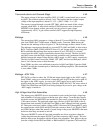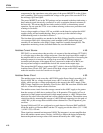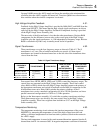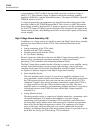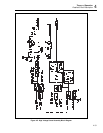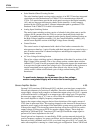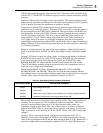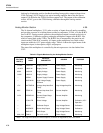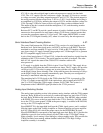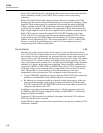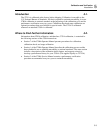
Theory of Operation
Detailed Circuit Description
4
4-35
IC U156 is a dac whose digital input is under microprocessor control via data latch
U155. The +15V supply is the dac’s reference voltage. Op amp U153A acts as a current-
to-voltage converter, providing outputs between 0V and -6.375V. The desired output for
the analog monitor function ranges from -2.56V to +2.56V. Level shifting and scaling is
accomplished by U153B, by summing the output of U153A and the reference voltage for
U156. Op amp U153B also forms an active two-pole filter to reduce wideband noise.
The output of the dac is routed to both the multiplexer, U151, and the analog monitor
comparator, U154A.
Resistors R171 and R170 provide a small amount of positive feedback around U154A to
ensure noise-free operation for small input voltages. Q150 forms a simple inverter that
converts the comparator output to 5V logic levels. This output, MONCOMP, is routed
back to the 5725A Digital assembly (A5), where it is acted on by the microprocessor.
Serial Interface/Guard Crossing Section 4-57.
The control link between the 5700A and the 5725A consists of a serial interface at the
hardware level. Serial data signals arrive via B-RCV and leave via B-XMIT. These are
translated to and from standard 5V logic levels by U160, an RS-232 interface chip that
runs from a single 5V supply. Internal charge pumps use C158 through C161 to generate
RS-232 compatible supply levels of ±10V.
A pair of dual optoisolators, U159 and U161, isolate the serial interface signals from the
remainder of the 5725A circuitry. The serial interface uses half of each pair. The other
half of U161 signals the status of the 5700A/5725A interface cable to the
microprocessor.
A 5V supply is available from the 5700A via pins 19 and 20 of J101. This supply drives
the optoisolator LED when the cable connections are intact. The 5V supply also provides
coil drive for K153. This relay’s contacts are in series with the coils of the other relays
on the High Voltage Sense assembly. Thus, if the cable becomes disconnected, all relays
on the High Voltage Sense assembly automatically open. The relays are configured so
that safety is maximized when they are open.
The remaining half of U159 signals to the 5700A when the 5725A is powered up. The
5725A +5V supply powers the LED of the optoisolator, whose output pulls B-CINT*
(pin 21 of J101) toward the 5700A supply common, B+5VCOM. This system is a
complement to the CABLEOFF signal provided to the 5725A processor.
Analog Input Switching Section 4-58.
The analog input switching section is the primary analog interface with the 5700A output
functions. Relay K108 serves exclusively to connect the output low lead of the 5725A to
the load. Relay K106 does the same for the low sense line. Line MCOM, when switched
to B-SENSE LO, serves as the low sense lead for the 5725A. Similarly, PACOM, which
ties to the 5725A system ground VCOM at the power supply, is switched to B-PACOM,
serving as the 5725A output low lead.
Signal BOOST IN is the input high lead from the 5700A signal sources, and is switched
from the inputs to the High Voltage Amplifier or Current Amplifier and sense amplifier
by K107. Relay K101 also selects the proper source for the B-FEEDBACK signal.
Signal B-FEEDBACK corresponds to the input high sense lead. Relay K111 provides the
capability to provide local sensing directly by the 5700A on the 5725A High Voltage
Sense assembly. Local sensing is used during ac voltage standby mode. This prevents the
5700A Oscillator from running without feedback when the 5725A High Voltage
Amplifier assembly is in standby.



